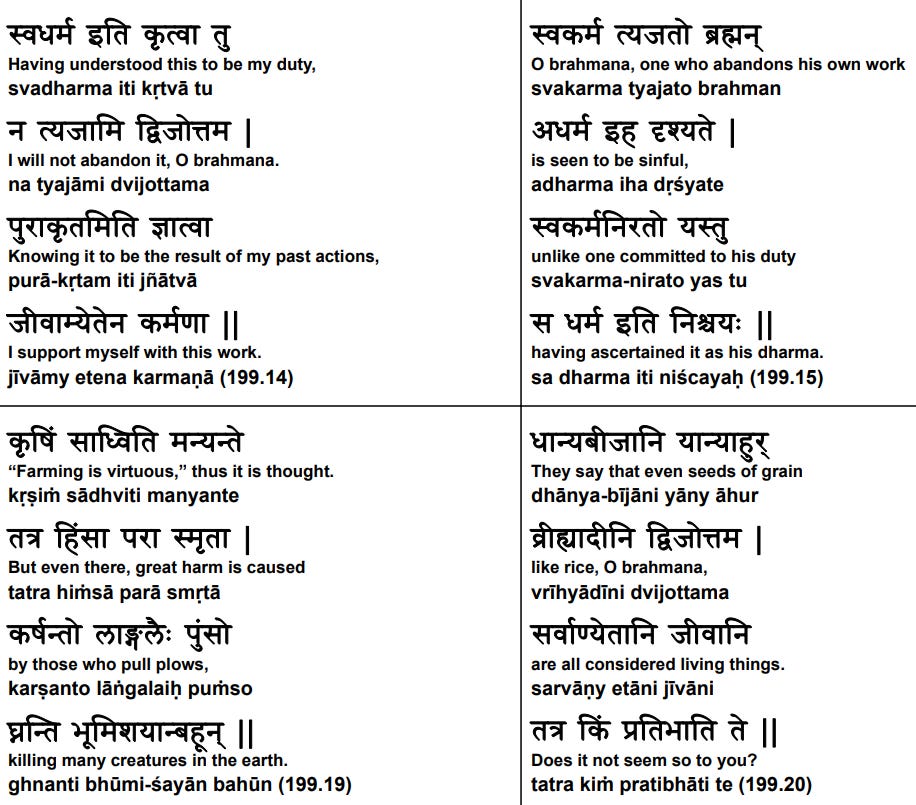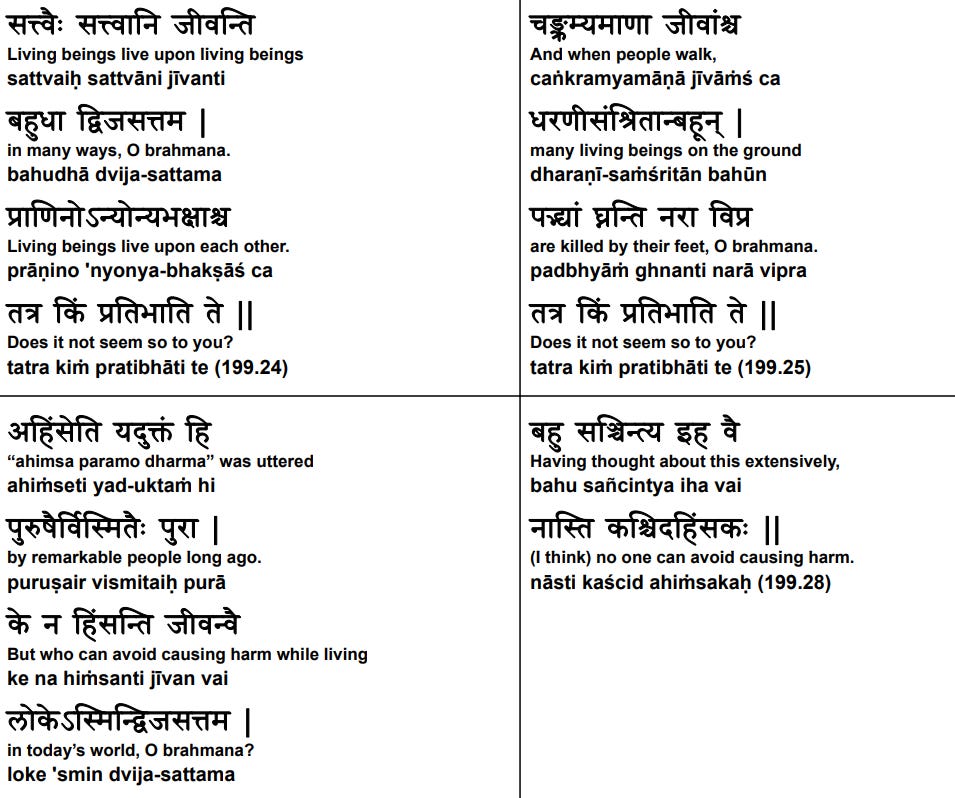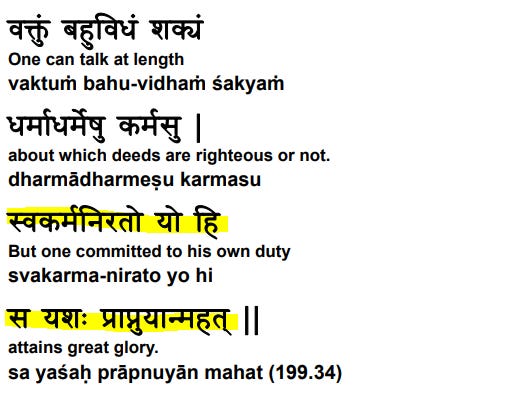Insightful newsletter of Drishtikone: Issue #319 - Manusmriti, Varnas, and Colonial Experiments
Artificial barriers to even study and reflection were installed for objective of dominance and subjugation. Bastardized version of our heritage was acceptable. And we faltered. A very deep look!
“Sister, in this country a Negro is always about to get killed, so that ain't nothing. But you tell your husband that a black man was ready to lay down his life for you. That's all.” ― Maya Angelou, The Heart of a Woman
What is living in Dharma - or the eternal law? It is not some god-given instruction manual on ethics or morality but the understanding that our current life and its situations are a reflection and sum-total of all the memories - our past lives, those of our ancestors, our species, and this existence itself. Fighting it with moral edicts and formulations takes one nowhere. It further adds to the memories of struggle and dichotomous reactions.
When our actions transcend the need to react to a life situation based on our past memory-bank, then we have a chance to “unwrite” our own software.
In that direction, the Sages pushed us to Moksha or liberation from the confines of the memory-banks (karmic structures) that we carry.
To get there we were urged to take responsibility for who we are.
The first step to taking responsibility is to understand that no matter what I am doing and what is happening to me in terms of life situations, it is MY DOING. No one - certainly no “god” - is responsible for my fate or destiny or the present, except me and my actions.
Given that, wherever I am today (based on my doing), I need to come to terms with that. As opposed to fighting it to move to a “better path” that someone else is following. My abilities, my qualities, my entire structure of intellect/physicality/emotions/life is a representation of my karmic bank, which is my doing in the first place.
Within that situation, I can perform the actions that come to me given those qualities in an intensely engaged but unattached manner. Do consciously, but without attachment. If I have to leave this body tomorrow I can. Until then, my engagement will be 100% in my work.
Let my qualities express to their fullest, without being impacted by the desire to live by another person’s ways.
Once this fundamental framework of my life’s actions is set, then the path to liberation will open up. The Guru or the means to liberation will approach.
We looked at the Vyadha Gita, from Mahabharat, in our earlier newsletter Issue #317 - Decoding Hindu Scriptures and 'Caste'. Check out its most instructive part to understand the concept of being content in your Varna (represented by the qualities of your karmas) while transcending it all completely. Vyadha, or the Hunter/Butcher, explains. (Source)
Here starts our journey into the experiments of our own deconstruction and the path back from this brink!
Understanding Varnas from Manusmriti
In a previous newsletter (Issue #317 - Decoding Hindu Scriptures and 'Caste'), we had discussed how the basis of the different varnas - Brahmin, Kshatriya, Vaishya, and Shudra has nothing to do with the family or lineage. Rather it has to do with one’s Karmic structure. There is no interventionist “God” or deva involved in who gets what type of qualities. It is one’s own doing.
Let us go further into this understanding with Manusmriti. In the first chapter, Rishi Manu explains how a human being attains to different types of qualities.
यथर्तुलिङ्गान्यर्तवः स्वयमेवर्तुपर्यये ।
स्वानि स्वान्यभिपद्यन्ते तथा कर्माणि देहिनः ॥ ३० ॥
(Translation in Hindi - जैसे ऋतुएँ ऋतु-परिवर्तन होने पर अपने आप ही अपने अपने ऋतुचिह्नों - जैसे, वसन्त आने पर आम्रमञ्जरी आदि, को प्राप्त करती हैं, उसी प्रकार देहधारी प्राणी भी अपने अपने कर्मों को (प्राप्त करते हैं।) - Source || Translation in English: Just as on the approach of the turn of the Seasons, each season, by itself, acquires its own seasonal characteristics,—so in the same manner living beings take up their respective lines of action. (Source))
The main sentiment here is that just as seasonal characteristics in nature manifest on the change of seasons, the human body takes on different qualities based upon their karmas (karmic substance/structure)
Dr. Ramchandra Verma Shastri suggests in his commentary that in this there is no intervention from any god or divine.
This is the verse that sets the context of the rest of the verses to come.
The next one goes into the body-parts analogy.
लोकानां तु विवृद्ध्यर्थं मुखबाहूरुपादतः ।
ब्राह्मणं क्षत्रियं वैश्यं शूद्रं च निरवर्तयत् ॥ ३१ ॥
(Translation in Hindi - फिर उस परमात्मा ने) प्रजाओं की विशेष वृद्धि के लिए मुख, बाहु, जंघा और पैरों से (क्रमश:) ब्राह्मण, क्षत्रिय, वैश्य और शूद्र को निर्मित किया । (Source) || Translation in English - With a view to the development of the (three) regions, He brought into existence the Brāhmaṇa, the Kṣatriya, the Vaiśya and the Śūdra, from out of His mouth, arms, thighs, and feet (respectively). (Source)
It is instructive that something similar has been discussed in the Vedas as well.
ब्राह्मणोऽस्य मुखमासीत् बाहू राजन्य: कृत: ।
ऊरू तदस्य यद्वैश्य: पद्भ्यां शूद्रो अजायत ।। -- यजु. ३१.११
Given the context of the previous verse where everything about one’s birth is decided by one’s past karmas - or basically, the complete karmic structure comprising of प्रारब्ध - Prarabdha as manifested in this birth from the overall संचित Sanchit karmas - one needs to look at this verse and its meaning in the same perspective.
Karmas decide. Birth. And the qualities of the born. Or योनी Yoni - the disposition/nature of birth and life.
Brahman, Kshatriya, Vaishya, Shudra - is not some family-given work or social level but the manifestation of one’s karmic structure. Like seasonality of the seasons.
मुख (Mukh or Face), बाहू (Bahu or hands), ऊरू (Uroo or thighs), and पाद्य (Padya or feet) is symbolic of the energy of the being of Brahman or the cosmic universal consciousness. It is not a physical person who is being talked about here, but an energy being - or rather consciousness.
This is evident from the next verse, which again has been notoriously misunderstood.
द्विधा कृत्वाऽत्मनो देहमर्धेन पुरुषोऽभवत् ।
अर्धेन नारी तस्यां स विराजमसृजत् प्रभुः ॥ ३२ ॥
[English Translation: Having divided his body into two halves, with the one half, the Lord became Male, and with the other half, Female; from her he produced Virāj. Medhatithi’s translation: The creation described here is apparently of another Being; but others have held that it is of the same Brahmā; the meaning being that the body that came out of the Egg being divided into two halves, ‘with one half he became Male’—i.e., he became a male being, capable of instilling semen—and ‘with the other half he became the Female’; that is, his body assumed the form of the Hermaphrodite, like Gaurī-Śaṅkara (combined in a single body). Or, it may mean that he crested the Female apart (from the Male).—Having created her, he produced, from her, by the act of procreation, that being whose well-known name is ‘Virāj.’ What is meant is that Prajāpati had recourse to his own daughter. This mention of the bifurcation of Prajāpati’s body is based upon the fact that the husband and wife differ only in their bodies, and in all functions, they are entirely united.—(32) Source]
The commentary on this verse shows the utter bankruptcy of the understanding of the context at hand. The discussion is from the cosmic being’s - ब्रह्मन - nature - a perspective that it is immanent, primordial substratum and consciousness within which everything manifests.
The qualities of Purush and Prakriti as the manifestation of the inert and the creative parts of the consciousness are an integral understanding within Samkhya Yoga as understood even in Bhagwad Gita.
The understanding of even Shiva as Ardhanareshwari is central to the Dharmic spiritual context.
द्विधा (dualistic) कृत्वा (creation) - in my understanding shares how the physical world came about.
द्विधा कृत्वाऽत्मनो देहमर्धेन - can be understood as the dualistic creation arose from the Atman or more closely - आत्मांश - given the quality of Purush or masculine and from the other half that of नारी or feminine. The existence expressed itself from the feminine. Viraj, the manifestation of this existence - was the result of the creative seed in the divine consciousness.
Now what is called as dualistic creation in the first line is said to be a manifestation (not creation) of the Prabhu or Divine being.
How?
Because the word used is सृजत् प्रभुः
सृजन is not creation. It is manifestation. The physical world is a manifestation of the underlying inertness (represented by the Purush) powered by the creativity (represented by the Prakriti) of the cosmic being.
This understanding and concepts pervade deeply in the Dharmic/Hindu understanding of the Brahman/Divine/Prabhu (indivisible, eternal, subtle and all-pervading) and Existence/Srishti/Physicality (which is dualistic).
Shiva is known to be half नर (masculine) and half नारी (feminine) - same concept as Yin and Yang, so does that mean that the masculine part of Shiva is Shiva’s son and the feminine part his daughter?
One does not know who this Medatithi was, but he had absolutely no sense of fundamental spiritual underpinnings of the Dharmic view of things.
Why are we insisting that the Divine be approached as the cosmic consciousness that is the primordial substratum in which everything manifests?
Because Rishi Manu starts off with that.
आसीदिदं तमोभूतमप्रज्ञातमलक्षणम् ।
अप्रतर्क्यमविज्ञेयं प्रसुप्तमिव सर्वतः ॥ ५ ॥
[English Translation: This (World) was in existence in the form, as it were, of dense Darkness,—unperceived, undifferentiated, incogitable, (hence) incognizable; as it was wholly merged in deep sleep. (Source)]
In the unmanifest unillumined state, the consciousness was inert. There was no perception, no differentiation, undefinable (अप्रतर्क्य) or knowable (विज्ञेयं) as everywhere it was in deep sleep (inert) state.
ततः स्वयम्भूर्भगवानव्यक्तो व्यञ्जयन्निदम् ।
महाभूतादि वृत्तोजाः प्रादुरासीत् तमोनुदः ॥ ६ ॥
[English Translation: Thereafter, the supreme being Hiraṇyagarbha, self-born, unmanifest and bringing into view this (universe), appeared,—dispelling darkness and having his (creative) power operating upon the Elemental Substances and other things. (Source)]
Then/Thereafter self manifesting Bhagwan (also called Hiranyagarbha in many scriptures, but not in this verse) expressed (व्यक्तो) itself as it manifested (व्यञ्जयन्निदम्).
योऽसावतीन्द्रियग्राह्यः सूक्ष्मोऽव्यक्तः सनातनः ।
सर्वभूतमयोऽचिन्त्यः स एव स्वयमुद्बभौ ॥ ७
[English Translation: He,—who is apprehended beyond the senses, who is subtle, unmanifest and eternal, absorbed in all created things and inconceivable,—appeared by himself. (Source)
First of all, one which is unmanifest can neither be a “He” nor “She”. So, the right way to understand this verse is -
That, which is beyond all senses (which is not observable) (योऽसावतीन्द्रियग्राह्यः) is subtle, unmanifest (सूक्ष्मोऽव्यक्तः) and eternal (सनातनः), and is beyond all comprehension thought (सर्वभूतमयोऽचिन्त्यः) and is self manifesting.
Do you see how Rishi Manu sets the contexts of his work? Brahm is not a physical being, its “limbs” are merely symbolic of energy qualities and existence a play of karmic dance.
Bottomline Context - Consistent with Dharmic Framework
The context of Manusmriti and the basic framework within which it is visualized by Rishi Manu is no different from any other Dharmic work/sharing. Rishi Manu’s entry point was always from the understanding that the Brahman or the Divine Cosmic Consciousness was inert in Purush form. Creative energy was provided by Prakriti or the feminine. This combination of masculine and feminine qualities of the consciousness (Ardhnareshwar) brought forth the manifesting and expressing state of the Divine.
In that creative and expressive divine or cosmic consciousness, the existence functioned. Based on the karmic structure taken on by different entities/jivas in the various and diverse Yonis - birth situations/lives. The karmic structure that one individual could result in forms from inanimate to animate, including human beings.
Amongst humans, the qualities and the abilities of a person are a representation of one’s own karmic structure (sum total of karmas to be used in this life - Prarabdha). Some karmic structures make one take on qualities of a Brahmin, some of a Kshatriya, and others lead to actions of Vaishya or Shudra. While Brahmin, Kshatriya, and Vaishya create their own source of earning - Education/Enlightenment, Rule/Leading, Merchant-trade; Shudras serve these three. Or in other words, Shudras are the employees.
For example, while Mukesh Ambani is the Owner of Reliance Industries and therefore a Vaishya, his employees are Shudras. Just as Sundar Pichai, even though he is the Google CEO, is an employee and therefore a Shudra.
Shudra is not a level in the social structure. It is a manifestation of the karmic structure and what actions it can lead one to.
Anyone who can break the karmic structure and attain to enlightenment is beyond all definitions or conjectures and predictions. No amount of estimations of one’s abilities or actions or qualities can be made. Since there is no karmic structure to go off of. That is why Yogis have no Varna.
There, the levels suggested by Manu and Krishna in Gita end in terms of their utility or significance.
Dharmic and more specifically Hindu spiritual understanding is very unique, ruthlessly sharp, uncompromisingly situated in the fundamental knowledge of this existence and its substratum. That has to be the entry point for every venture or journey that we undertake in any works of our Sages.
Those who have known nothing other than monotheistic mumbo-jumbo and ideological story-telling - that was sold as religious verity - cannot make the leap from the make-believe world of a belief system where “One world Order” was the objective to a pluralistic world of seeking the answers to this existence.
In that seeking, the Sages understood and experienced the Truth. One Eternal Truth. Sharing of that Truth, cannot be approached from a mind lazy and dishonest enough to remain in the confines of comforting stories promoted as “Only Truth” by sheer backing of force, violence, genocide, and fear.
It is time to reject the very basis of what has been lazily and crudely translated and commented upon with respect to the works of our Sages.
Acknowledge Contamination Also
Even when the scriptural import and context are specific and consistent, then how is it that their interpretations were contaminated and bastardized while a faulty, dangerous, and destructive narrative was put forth - that of castes being Brahmin, Kshatriya, Vaishya and Shudra?
How is it that only some gotras and family names took positions of work that should have never happened for that was completely and fundamentally inconsistent with everything that one can get from the texts like Manusmriti and Bhagwad Gita?
That such empowerment, albeit inconsistent with the Dharmic framework - happened is a verity. That many were discriminated is also a fact. That our society took on a narrative and made that into a practice and passed on as the only understanding of one’s own heritage is also now a social reality for us.
How did it come to this?
Before we go on, let us look at a curious experiment that was done by an Iowa teacher named Jane Elliott with her students to teach them the curse of discrimination and how it can lead to even hate.
A Class Divided: Artificially Orchestrated Social Divisions Ingrained as Discrimination
She divided the class into two groups: One group was explicitly superior to the other. Why? Because the teacher had said so. No other reason.
Ms. Elliott announced to the students on the first day that she knows extremely well that the Blue-eyed people are better, more intelligent, and sharper than the Brown-eyed kids. In fact, she herself was blue-eyed, so she knew.
She then picked on a few anecdotes from what the brown-eyed kids had shared earlier with her separately – like how the Dad of a brown-eyed kid had kicked him – to drive home the point that brown-eyed people are bad and inferior.
To reinforce the differences, she set some rules – the blue-eyed kids will get extra time for recess, get first access to the water fountain, will get access to the swings and playground equipment more. And, the worse of all – the brown-eyed kids had to wear a scarf so everyone knew what eye color they were.
That day she did a puzzle with the two groups. The brown-eyed finished in 5 minutes and the blue-eyed finished in 3 minutes. Further reinforcing the belief that blue-eyed people were indeed smarter. In fact, one blue-eyed kid called another kid “brown-eyed” – and the latter complained that his classmate was calling him “nasty names”.
When she asked him what was he saying – he said he is calling me “brown-eyed” which was a very mean thing to say! When she asked the kid who had said that, he replied that his classmate was indeed brown-eyed! When she asked but did he call him “brown-eyed” because he was that or because he wanted to say something mean.
The blue-eyed kid had a mischievous smile and kept quiet.
The answer was obvious.
What he said was not as important as why he had said that. He knew about his meanness and nastiness and so did his victim!
An important lesson was – sometimes one can do very nasty things while hiding under the cloak of “facts”.
The next day, she reversed the experiment. She said, that she had lied the day before and actually brown-eyed people were better. She again picked on a few anecdotes from kids’ lives to drive home the point. These were facts but they were cherry-picked to create a narrative that she wanted to float. And the kids believed.
Of course, all the privilege-giving rules of the fountain and the playground access were now reversed and the blue-eyed kids were wearing the scarves!
The roles were now reversed. The nastiness was now coming from the opposite direction. The same puzzle was done again. And, this time the blue-eyed kids did it in 4 minutes and some seconds, while the brown-eyed kids did it in two and a half minutes. When the brown-eyed kids were asked why did they take so long the day before?
They unanimously said that “we were thinking of our collars.” The collars had become a mental barrier they could not cross.
Can hate and discrimination be orchestrated by overplaying differences that are unimportant by making them critical to social distinctions?
The roots of these orchestrated divisions by ingraining them as social differences go back to Colonial times.
Social Structures Orchestrated by Colonialists basis Faulty Interpretations
Colonial anthropology replaced the prevalent Indian history with its own narrative. For example, Colin Mackenzie’s rendering of the Indian ethnography was very different from the caste-system-centric version of the later British colonial version. And in that change lies the real story.
The British brought with them the monotheistic mindset that used Judeo-Christian theology as the guide. Their maps and frameworks were all set. They set about defining the Indian culture based upon those sets of maps. Unfortunately for us, we ingrained that negativity so deeply that when we defined our laws, we also defined ourselves in a negative context.
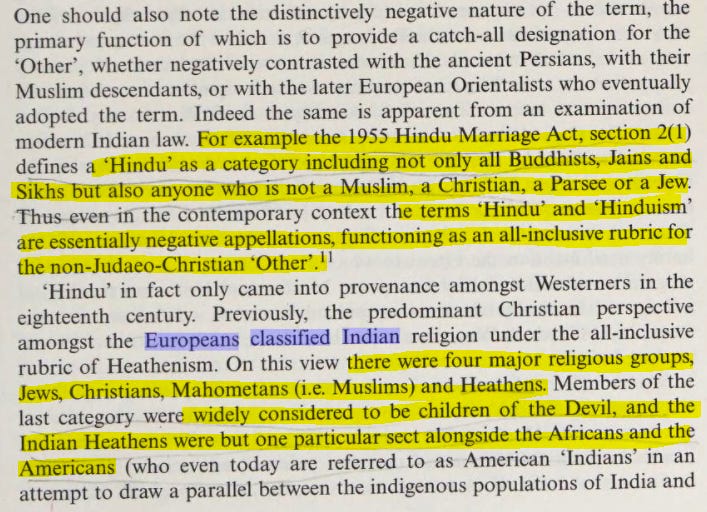
This use of maps, definitions, and frameworks that did not belong to the Indian context and forcing their own interpretation of the works that the British termed as “Heathen” to start with, had its consequences.
As we have seen in the two newsletters, this one and the earlier one, the words and import of Manu and Bhagwad Gita have not just been inaccurately translated but given the overall context of Dharmic spiritual understanding, it is completely nonsensical.
But that became the go-to version of what the Indians had. And, these bastardized versions of Dharmic spiritual works became the basis of a socially orchestrated change where one group was given privileges and power to create wider chasms to keep the fires on. Quite like the experiments by Jane Elliott in Iowa!
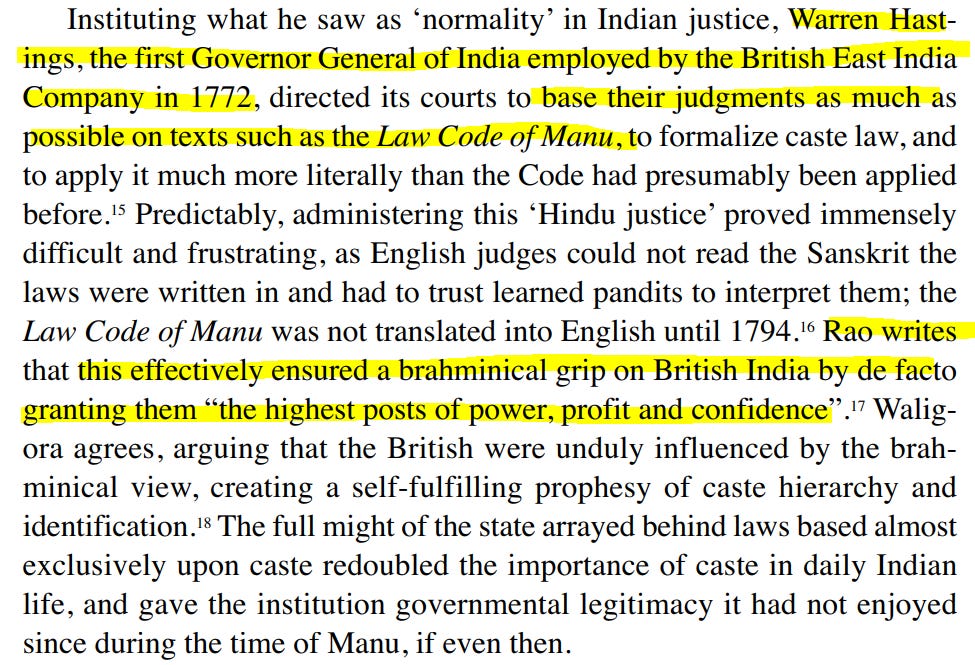
What was set in motion was far more devastating than any other vestige of discrimination that had seeped in the general social mores of pre-British times due to motivated translations and commentaries.
A curious happenstance in a country with many learned scholars who had a deep knowledge of the Dharmic spiritual framework.
Was this the “gatekeeping bias”? Were only those interpretations and commentaries allowed to exist and surface that deliberately and comprehensively distorted the ancient works?
Those are important questions without which our understanding of why we are where we are will never be comprehensive.
We owe it to ourselves to dive deep into our Dharmic heritage, not with the crutches of interpretations and commentaries passed down from the past years but to look at our works with fresh eyes… ourselves.
Before that, we need to ground ourselves in the fundamentals of Dharmic spirituality and its import. Without that, whatever we will approach will be turned ugly. As Medhatithi did with Manusmriti.
Finally, Manusmriti has been made into a political and religious lightning rod for everything that is wrong with Hinduism and Dharma purely on the basis of faulty and bastardized interpretations. That has stopped many - including me until now - to even attempt an independent and fair read of the work.
We need to realize that this was another intended objective of the British Colonial masters and those who continued their narratives into our laws and social narratives many years hence.
Even though it was an artificial barrier, but one of the most effective ones in stonewalling the coming generations of Hindus to reclaim their heritage on their own terms!
market corner: 10 quick bytes
Volatile weather may hit pulses yield, drag Kharif output down (Source)
E-way GST bill generation picks up pace ahead of the festive season (Source)
Cargill launches 'Digital Sathi', a mobile-first local online service platform (Source)
Delhi-Mumbai Expressway to fetch Rs 1,000 to 1,500 cr revenues every month: Nitin Gadkari (Source)
Amazon creates 110,000 seasonal jobs in India ahead of festive season (Source)
30 cos may float public issues in Oct-Nov to mop up Rs 45,000 crores (Source)
Solar industry demand raises the temperature in silicon market (Source)
Gautam Adani says group to invest $20 billion on clean energy technology in 10 years (Source)
Govt targets on-boarding 35 lakh handloom Workers And 28 Lakh Weavers To Its E-Marketplace To Increase Their Market Access (Source)
India likely to block Chinese investment in insurance giant LIC (Source)
What is the Evergrande scandal in China? It has impacted the global markets and we need to understand its fundamentals. Evergrande is China's largest property develop which is on the verge of collapse now.
It is all but sure that it will default on its interest payments on the bonds it has used to finance its operations. Its impact for now will be mostly local and domestic to China, but a shock to the Chinese economy could send ripples across the globe.
The Organization for Economic Cooperation and Development (OECD) has said that China can handle the blow from the Evergrande disaster. (Source)
However, whatever the spin from different sources, here are some numbers.
2 trillion yuan (~$300 billion): Evergrande’s debts as of June, according to Caixin. The amount is equivalent to around 2% of China’s GDP
$120 million: interest payments due to bondholders on Thursday, including nearly $84 million on dollar bonds. Another interest payment is due next week
29%: Share of real estate and related industries as a percentage of Chinese GDP, according to an NBER paper (pdf)
To get more information on this topic, please watch this report from WION TV
nota bene
National Single Window System: Union Minister for Commerce and Industry Piyush Goyal on Wednesday (22 September) launched the National Single Window System (NSWS) for businesses and investors. The facility will provide a single platform to enable investors to identify and obtain approvals and clearances needed by investors, entrepreneurs, and businesses in India. (Source)
AUKUS and France: India and Japan will not be joining the newly announced US's trilateral security partnership with Australia and Britain - dubbed AUKUS- to counter China's increased activities in the Indo-Pacific region. "The announcement of AUKUS last week was not meant to be an indication, and I think this is the message the President also sent to (French President Emmanuel) Macron, that there is no one else who will be involved in security in the Indo-Pacific," White House press secretary Jen Psaki told reporters at her daily news conference on Wednesday. (Source)
China fudged Ease of Doing Business Data: An independent scrutiny by leading US law firm WilmerHale shows China's massive data manipulation to hide slippage in the World Bank Group's Ease of Doing Business (EODB) rankings. At the same time, no irregularities were found in Indian data, the probe shows adding the country remains a preferred, reliable and trustworthy investment destination for the world. Last week, the World Bank decided to discontinue publication of its EODB report following allegations of data irregularities due to pressure by some top bank officials to boost China's ranking in 2017. (Source)
TikTok Craze of Stealing / Damaging School Property: A new, destructive TikTok craze has teens stealing and damaging property at schools. The challenge has spread here locally, with districts from New Jersey to Connecticut reporting thousands of dollars in damage while issuing warnings to students and parents, CBS2’s Christina Fan reported Monday. From stealing school supplies to trashing bathrooms, students around the country are jumping on a viral TikTok trend. (Source)
Chinese Electric Cars Bust: Visitors to Byton Ltd.’s website are greeted with color-saturated images of shiny electric cars gliding along manicured streets. Those paying a visit to the automaker’s factory in Nanjing, eastern China may be less impressed. The plant is modern and huge, gleaming under the hot summer sun. But there’s total silence. Production has been suspended since the pandemic began and there’s noone around except for a lone security guard. It’s a similar situation across town at Bordrin Motors. Weeds dot the factory’s perimeter and there’s a court notice pasted to the main gate announcing the electric carmaker’s bankruptcy. (Source)
Prosus' $4.7 Billion Indian online payment bet: European technology giant Prosus NV said it struck a $4.7 billion deal—its largest-ever acquisition—to buy Indian payments platform BillDesk, the latest investor bet that more and more consumers will conduct transactions online. The acquisition will bring Prosus’s cumulative investment in Indian tech to more than $10 billion since 2005, as the company seeks to profit from what was the world’s fastest-growing major economy before the coronavirus pandemic. (Source)
To fully understand this bid for online payments in India - check this video below. Also read - Issue #215 - The UPI/RuPay Juggernaut
video corner: Making of a Jihadi
How is a Jihadi created and cultivated? What do those who are in the business of making Jihadi robots - designed to kill at instruction do to achieve that? Here is a very interesting discussion by one who calls himself an “Ex-Jihadi”.
SUPPORT DRISHTIKONE: If you consider our work important and enriching and would like to contribute to our expenses, please click on the amount below to send in your contribution. You have the option of sending a monthly or a one-time contribution. You can do it in US Dollars or Indian Rupees.
US Dollars: One-Time: $25 . $50 . $100 . $200 || Monthly: $5 . $15 . $25 . 50
Indian Rupees: One Time: Rs 100 . Rs 500 . Rs 1000 . Rs 2500 || Recurring: Rs 100 . Rs 500 . Rs 1000
Pound Sterling: One-Time: £25 . £50 . £100 || Monthly: £10 . £25 . £50
If you like this post - please share it with someone who will appreciate the information shared in this edition.
If you like our newsletter, please share it with your friends and family
Today’s ONLINE PAPER: Check out today’s “The Drishtikone Daily” edition. - THE DRISHTIKONE DAILY
Nuzzle Tweets “newsletter” - with tweets and stories that we read and follow in a day in one compilation on a daily basis -Nuzzle Drishtikone - just another way to keep up with things.





